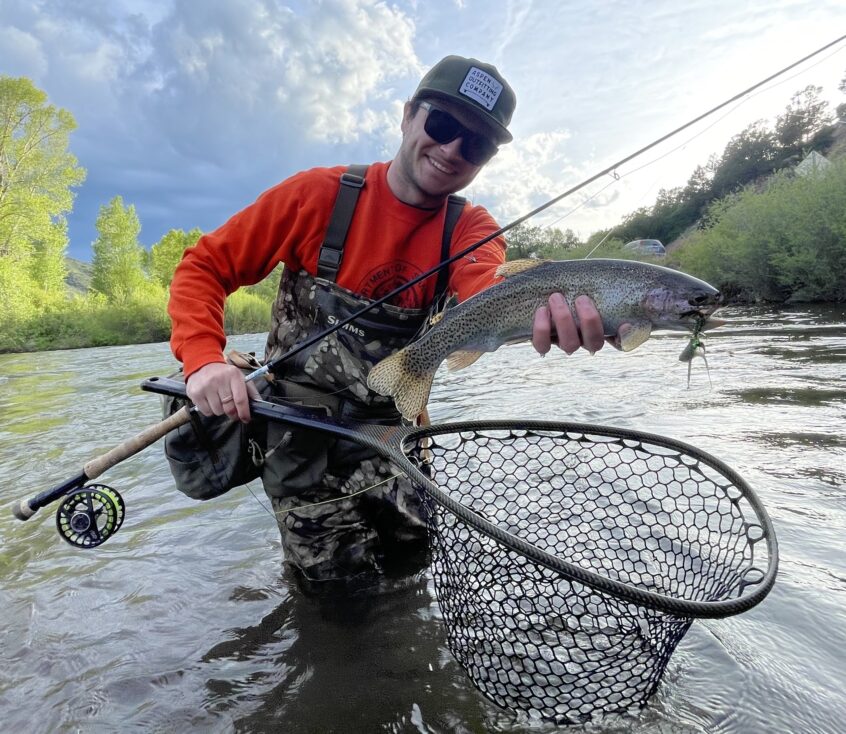Flows and Water Clarity
Flows are at 1680 cfs below Maroon Creek and 2640 cfs at Emma. Water clarity is low.
Overview
It has been a high-water year so far, and after dropping/clearing water last week, increased flows and decreased visibility are the hallmark of the river once again! Clear skies, warm days, and an unbridled natural flow from the top of the drainage this week means that we will be seeing a full river for a while still. Break out those bigger bugs that were working earlier this spring, increase your tippet size, and get ready to fight fish AND river! Have fun and mix it up, intrepid anglers will may even be rewarded with hopper/dropper rigs and streamers in certain locations.
As is normal during this time of the year, flows generally peak around midnight and bottom out around noon before climbing again. As far as fishing goes, focus your efforts on the mid/late morning through mid/late afternoon for the best results. The fish are hungry and feeding opportunistically on worms, big Stoneflies and Caddis nymphs right off of the bank and in slower water! If you’re fishing earlier or later in the day, larger nymph patterns and streamers have been the ticket. During the middle of the day we’re finding a lot of success on caddis nymphs.
The Streamer fishing has been good, but you’ll need to cover some water and focus on soft pockets off of the bank, eddies and seams that come off of structure. Don’t be afraid to throw some flashier/brighter colors in these conditions. If you’re fishing lower down on the Roaring Fork, you may even find some fish willing to eat a hopper-dropper set up. We promise you’ll have some fun mixing it up!
With increased flows, it’s always important to be mindful of safety when out on the river. At this water level, the river is very powerful and poor visibility can make wading difficult. Be sure to wear a wading belt when you fish, and don’t take any unnecessary risks when moving around the river. The fish are pushed up against the bank anyway during these flows! There’s no need to try to get out into the middle.
As mentioned above, conditions will probably be variable this week. If you want more in depth information on a specific day this week, give us a call or drop by the shop to get the most recent conditions and information.
Changing conditions require you to adapt as an angler, making this a fun time of year to put your skills to the test! There is some great fishing to be had, but you need to know when and what to fish. As always, our guides are on the water every day and in tune with these changes. Booking a guide trip is a great opportunity to brush up on technique before the summer season starts and increase your chances of landing fish!
Common Hatches and Food Sources
Stoneflies, Worms and Caddis
Bigger nymphs like stones, worms and caddis work well during increased flows and decreased visibility. If you can fish big, why wouldn’t you! We’re seeing caddis get active on the fork, so fishing Hare’s Ears, Plan B Caddis, Frenchies, Sparkle Caddis, and UV Caddis has been working well. Any jigged flies with CDC have been working well too!
Hot flies & Techniques
Nymphs
Point Flies
Hot Flies: Pat’s Rubber Legs/Girdle Bug (size black, coffee, brown 6-14), 20 incher (size 8-14, natural), Prince Nymph (size 8-16), Squirmy or San Juan Worm (Tan, Pink, Blood Worm), Guide’s Choice Hare’s ear (size 12-16), Frenchie Style flies (12-16), Perdigon (pearl, size 16).
Tungsten jigs with hot collars (yellow, brown, pink, size 12-16), Pheasant Tails (black, natural, flashback 12-16).
Dries:
Caddis are hatching on the fork, and in certain spots you can find dry fly action, particularly lower down the valley. That being said, the high water has made dry fly fishing a bit tough the last few days. Midge and BWO hatches are still happening on the fork, but the dry fly fishing has been very sporatic given the high flows. If you’re feeling adventurous and want to target hard to reach pockets right off the bank, tie on a Stimulator, Chubby or Hippy Stomper and drop a nymph off of it.
Hot Flies: Missing Link Caddis (14-16), Royal Stimulator (classic or rubberlegs, 10-14)
Streamers:
Bring a streamer rod with you this time of year! It never hurts to target some structure and see what happens! It’s been a little streaky, but we love fishing streamers whenever we can!
Hot Flies: Sex Dungeons (White, Grizzly, Yellow, Black, Size 2) Mini Dungeons (white, natural, size 8), Thin Mint (size 8-10), Trick Or Treat (size 6), Mini Drunk and Disorderly (Olive, Yellow, size 8)
Motor Oil (black, size 6), Slumpbuster (natural, size 8-12),
Techniques
Nymphing is the most productive technique during this time of year. Finding pockets of slower water and using weight to get your flies down will be crucial to success. Leading with larger jig style or tungsten patterns has been a very productive technique for getting your rigs into the strike zone
Decreased visibility during runoff provides us the opportunity to fish larger, flashier flies and use heavier tippet. Adjust size, flash and tippet selection depending on the water clarity where you’re fishing. During high water, fish get pushed into pockets and eddies closer to the bank.
Streamers are also an important tool in your toolbox during the summer! Small streamers with a slower retrieve tend to be best when the water is clear. In murky water, try the big nasty flashy stuff! It’s a ton of fun. Focus your efforts on deep pools and structure and cover a lot of water for the best results.
Information About The Roaring Fork
The Roaring Fork River is a freestone river that runs 70 miles from Independence Pass through Aspen, Basalt, and Carbondale until it reaches its confluence with the Colorado River in Glenwood Springs. The cold, clean waters of this famous river support an incredible array of aquatic life including brown, rainbow and cutthroat trout. The Roaring Fork is designated as a “Gold Medal” fishery, meaning it offers some of the best trout fishing in the nation to beginners and seasoned anglers alike.

